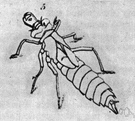o·vi·pos·i·tor
(ō′və-pŏz′ĭ-tər)n.
1. A tubular structure, usually concealed but sometimes extending outside the abdomen, with which many female insects deposit eggs.
2. A similar organ of certain fishes and turtles.
American Heritage® Dictionary of the English Language, Fifth Edition. Copyright © 2016 by Houghton Mifflin Harcourt Publishing Company. Published by Houghton Mifflin Harcourt Publishing Company. All rights reserved.
ovipositor
(ˌəʊvɪˈpɒzɪtə)n
1. (Zoology) the egg-laying organ of most female insects, consisting of a pair of specialized appendages at the end of the abdomen
2. (Zoology) a similar organ in certain female fishes, formed by an extension of the edges of the genital opening
Collins English Dictionary – Complete and Unabridged, 12th Edition 2014 © HarperCollins Publishers 1991, 1994, 1998, 2000, 2003, 2006, 2007, 2009, 2011, 2014
o•vi•pos•i•tor
(ˌoʊ vəˈpɒz ɪ tər)n.
1. an organ at the end of the abdomen in certain female insects, through which eggs are deposited.
2. a similar organ in other creatures.
Random House Kernerman Webster's College Dictionary, © 2010 K Dictionaries Ltd. Copyright 2005, 1997, 1991 by Random House, Inc. All rights reserved.
o·vi·pos·i·tor
(ō′və-pŏz′ĭ-tər) A tube in many female insects that extends from the end of the abdomen and is used to lay eggs.
The American Heritage® Student Science Dictionary, Second Edition. Copyright © 2014 by Houghton Mifflin Harcourt Publishing Company. Published by Houghton Mifflin Harcourt Publishing Company. All rights reserved.
ThesaurusAntonymsRelated WordsSynonymsLegend:
| Noun | 1. |  ovipositor - egg-laying tubular structure at the end of the abdomen in many female insects and some fishes ovipositor - egg-laying tubular structure at the end of the abdomen in many female insects and some fishesorgan - a fully differentiated structural and functional unit in an animal that is specialized for some particular function |
Based on WordNet 3.0, Farlex clipart collection. © 2003-2012 Princeton University, Farlex Inc.